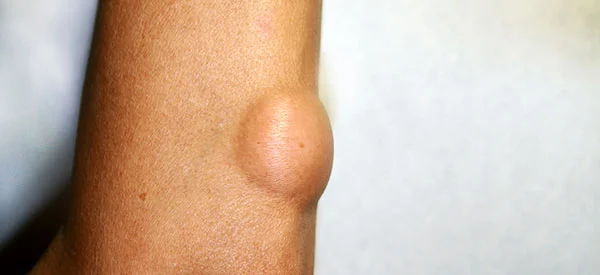Painless swellings can appear at any point on the body, including the scalp. These can be described as sebaceous cysts or lipomas. Swellings on the scalp are often categorized as sebaceous cysts.
The treatment for both is the same: the accumulated fat tissue under the skin needs to be removed through a small incision. The treatment can be completed in a matter of minutes. (1)

What is a Sebaceous Cyst?
A sebaceous cyst is a generally harmless and painless lump that forms under the skin. Medically known as a “lipoma,” these formations consist of fat cells (adipose tissue). Sebaceous cysts can appear at any age and almost anywhere on the body, but they are most commonly found on the neck, shoulders, back, chest, and abdomen. (2)
Mobile Upon Touch: They are usually free-moving under the skin and have a soft texture.
Painless: Most of the time, they are painless, but they can cause pain when they grow large enough to compress nerves.
Slow Growth: Sebaceous cysts typically grow slowly. While some may stay the same size for years, others may gradually increase in size.
Generally Harmless: Most sebaceous cysts are benign and do not pose a cancer risk. However, there is a rare cancerous type called liposarcoma.
Causes of Lipomas:
The exact cause of lipomas is not fully understood, but certain factors are thought to trigger such formations:
Genetic Factors: Lipomas appear more frequently in some families, suggesting a possible genetic component.
Age: Lipomas are more common in middle-aged and older adults, but they can occur at any age.
Injuries: In some cases, lipomas develop following an injury or trauma. However, this link has not been definitively proven and remains controversial.
Other Health Conditions: Certain health conditions, especially those involving multiple lipomas (lipomatosis), may be associated with the development of lipomas.
Lifestyle Factors: There is no clear evidence that lifestyle factors such as diet and exercise directly influence the formation of lipomas.
How to Get Rid of Sebaceous Cysts?
In most cases, lipomas do not go away on their own and may grow over time. However, they typically do not require treatment as they are not a health risk. Treatment options for lipomas that become bothersome or are removed for cosmetic reasons may include:
Surgical Removal: The most common treatment method is to surgically remove the lipoma. This procedure is usually done under local anesthesia and ensures the complete removal of the lipoma.
REFERENCE
- Charifa, A., Azmat, C. E., & Badri, T. (2018). Lipoma pathology.
- Manor, E., Sion-Vardy, N., Joshua, B. Z., & Bodner, L. (2011). Oral lipoma: analysis of 58 new cases and review of the literature. Annals of diagnostic pathology, 15(4), 257-261.